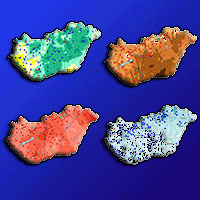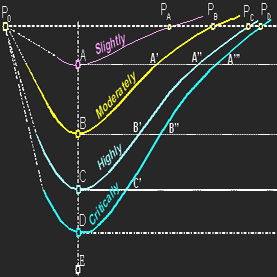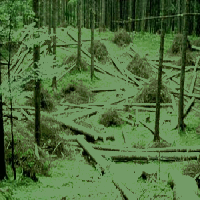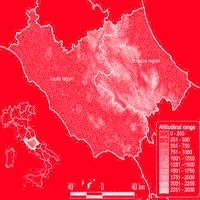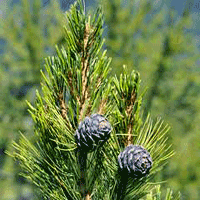The forests of Great Britain (GB) are an important resource, which are under threat from climate change and exotic pests and diseases. The forest sector has been proactive in launching initiatives and supporting activities to improve the resistance and resilience of forests in GB. These interventions can be directed at forests at a range of scales, from genetic to national. This article describes the range of potential and actual actions focused on adapting Britain’s forests to climate change and damage from pests and diseases. However, there are also barriers to improving the resilience of forests in GB and these are also discussed.
Keywords
, , , , ,
Citation
Leslie A, Wilson E, Park A (2024). Increasing resistance and resilience of forests, a case study of Great Britain. iForest 17: 69-79. - doi: 10.3832/ifor4552-017
Academic Editor
Marco Borghetti
Paper history
Received: Dec 28, 2023
Accepted: Feb 13, 2024
First online: Mar 21, 2024
Publication Date: Apr 30, 2024
Publication Time: 1.23 months
© SISEF - The Italian Society of Silviculture and Forest Ecology 2024
Open Access
This article is distributed under the terms of the Creative Commons Attribution-Non Commercial 4.0 International (https://creativecommons.org/licenses/by-nc/4.0/), which permits unrestricted use, distribution, and reproduction in any medium, provided you give appropriate credit to the original author(s) and the source, provide a link to the Creative Commons license, and indicate if changes were made.

Breakdown by View Type
(Waiting for server response...)
Article Usage
Total Article Views: 1563
(from publication date up to now)
Breakdown by View Type
HTML Page Views: 993
Abstract Page Views: 280
PDF Downloads: 267
Citation/Reference Downloads: 0
XML Downloads: 23
Web Metrics
Days since publication: 37
Overall contacts: 1563
Avg. contacts per week: 295.70
Article Citations
Article citations are based on data periodically collected from the Clarivate Web of Science web site
(last update: Feb 2023)
(No citations were found up to date. Please come back later)
Publication Metrics
by Dimensions ©
Articles citing this article
List of the papers citing this article based on CrossRef Cited-by.
(1)
Adams JM, Piovesan G, Strauss S, Brown S (2002)The case for genetic engineering of native and landscape trees against introduced pests and diseases. Conservation Biology 16 (4): 874-879.
CrossRef |
Gscholar
(2)
Aldhous JR (1997)British forestry: 70 years of achievement. Forestry 70 (4): 283-291.
CrossRef |
Gscholar
(3)
Ambrose-Oji B, Atkinson G, Petr M (2019)Woodland managers’ understanding of resilience and their future information needs. Forestry Commission, Edinburgh, UK, pp. 10.
Gscholar
(4)
Bailey S (2007)Increasing connectivity in fragmented landscapes: an investigation of evidence for biodiversity gain in woodlands. Forest Ecology and Management 238 (1-3): 7-23.
CrossRef |
Gscholar
(5)
Barham E, Sharrock S, Lane C, Baker R (2016)The international plant sentinel network: a tool for regional and national plant protection organizations. EPPO Bulletin 46 (1): 156-162.
CrossRef |
Gscholar
(6)
Barsoum N, Gill R, Henderson L, Peace A, Quine C, Saraev V, Valatin G (2016)Biodiversity and rotation length: economic models and ecological evidence. Research Note 22, Forestry Commission, Edinburgh, UK, pp. 10.
Gscholar
(7)
Bastrup-Birk A (2010)Forest categories in Denmark based on the EFT. In: Proceeding of the “European Forest Types Technical Workshop”. Bordeaux (France) 19-21 May 2010. United Nations Economic Commission for Europe, Geneva, Switzerland, pp. 23.
Online |
Gscholar
(8)
Beauchamp K (2016)How diverse is your forest? ICF News, Edinburgh, UK, pp. 24-26.
Gscholar
(9)
Bell S (1998)Forest design planning, a guide to good practice. The Forest Authority, Edinburgh, UK, pp. 78.
Gscholar
(10)
Borrill P (2017)More, bigger, better and connected - working at landscape scale. Woodland Trust, Grantham, UK.
Online |
Gscholar
(11)
Boshier D, Buggs RJA (2015)The potential for field studies and genomic technologies to enhance resistance and resilience of British tree populations to pests and pathogens. Forestry 88 (1): 27-40.
CrossRef |
Gscholar
(12)
Brang P, Spathelf P, Larsen JB, Bauhus J, Boncìna A, Chauvin C, Drössler L, García-Güemes C, Heiri C, Kerr G, Lexer MJ (2014)Suitability of close-to-nature silviculture for adapting temperate European forests to climate change. Forestry 87 (4): 492-503.
CrossRef |
Gscholar
(13)
Broadmeadow M, Ray D, Sing L, Poulsom L (2002)Climate change and British woodland: what does the future hold? Forest Research, Annual Report and Accounts, Edinburgh, UK, pp. 70-83.
Gscholar
(14)
Broadmeadow MSJ, Webber JF, Ray D, Berry PM (2009)An assessment of likely future impacts of climate change on UK forests. In: “Combating Climate Change - A Role For UK Forests” (Read DJ, Freer-Smith PH, Morison JIL, Hanley N, West CC, Snowdon P eds). The Stationery Office, Edinburgh, UK, pp. 67-98.
Gscholar
(15)
Brown N (1997)Re-defining native woodland. Forestry 70 (3): 191-198.
CrossRef |
Gscholar
(16)
Brown A, Webber J (2008)Red band needle blight of conifers in Britain. Forestry Commission Research Note 2, , Edinburgh, UK, pp. 8.
Gscholar
(17)
Brown N, Fisher R (2009)Trees outside woods. A report to the Woodland Trust, Department of Plant Sciences, Oxford University, Oxford, UK, pp. 20.
Gscholar
(18)
Brown I, Ridder B, Alumbaugh P, Barnett C, Brooks A, Duffy L, Webbon C, Nash E, Townend I, Black H, Hough R (2012)Climate change risk assessment for the biodiversity and ecosystem services sector. DEFRA, London, UK, pp. 4.
Gscholar
(19)
Buizer M, Lawrence A (2014)The politics of numbers in forest and climate change policies in Australia and the UK. Environmental Science and Policy 35: 57-66.
CrossRef |
Gscholar
(20)
Cavers S, Cottrell JE (2015)The basis of resilience in forest tree species and its use in adaptive forest management in Britain. Forestry 88 (1): 13-26.
CrossRef |
Gscholar
(21)
Clark JR, Hemery GE, Savill PS (2008)Early growth and form of common walnut (Juglans regia L.) in mixture with tree and shrub nurse species in southern England. Forestry 81 (5): 631-644.
CrossRef |
Gscholar
(22)
Climate Change Accord (2015)The climate change accord: a call for resilient forests, woods and trees. Forestry Commission, Edinburgh, UK, pp. 16.
Gscholar
(23)
Côté IM, Darling ES (2010)Rethinking ecosystem resilience in the face of climate change. PLOS One (8): 7.
Gscholar
(24)
Critchley W, Siegert K (1991)A manual for the design and construction of water harvesting schemes for plant production. FAO, Rome, Italy.
Online |
Gscholar
(25)
De Albaquerque FS, Rueda M (2010)Forest loss and fragmentation effects on woody plant species richness in Great Britain. Forest Ecology and Management 260: 472-479.
CrossRef |
Gscholar
(26)
DEFRA (2011)Biodiversity 2020: A strategy for England’s wildlife and ecosystem services. DEFRA, London, UK, pp. 45.
Gscholar
(27)
DEFRA (2018)Tree Health Resilience Strategy. DEFRA, London, UK, pp. 63.
Gscholar
(28)
DEFRA (2019)UK Plant Heath Risk Register. DEFRA, London, UK, web site.
Online |
Gscholar
(29)
DEFRA (2021)The England Trees Action Plan 2021-2024. DEFRA, London, UK, pp. 36.
Gscholar
(30)
De Vries SM, Alan M, Bozzano M, Burianek V, Collin E, Cottrell J, Ivankovic M, Kelleher CT, Koskela J, Rotach P, Vietto L (2015)Pan-European strategy for genetic conservation of forest trees and establishment of a core network of dynamic conservation units. European Forest Genetic Resources Programme (EUFORGEN), Biodiversity International, Rome, Italy, pp. 40.
Gscholar
(31)
Ennos R, Cottrel J, O’Brien D, Hall J, Mason B (2020)Species diversification - which species should we use. Quarterly Journal of Forestry 114 (1): 33-41.
Gscholar
(32)
EUFORGEN (2021)United Kingdom - member countries. Web site.
Online |
Gscholar
(33)
EC (2023)Guidelines on closer-to-nature forest management. European Commission, Directorate-General for Environment, Publications Office of the European Union, Luxembourg, pp. 98.
Gscholar
(34)
Forestry Commission (2003)National Inventory of Woodland and Trees, Great Britain. Forestry Commission, Edinburgh, UK, pp. 58.
Gscholar
(35)
Forestry Commission (2014a)Phytophthora ramorum - Frequently Asked Questions. Forestry Commission, Edinburgh, UK.
Online |
Gscholar
(36)
Forestry Commission (2014b)Building wildfire resilience into forest management planning. Forestry Commission Practice Guide 22, Forestry Commission, Edinburgh, UK, pp. 44.
Gscholar
(37)
Forestry Commission (2023a)Forestry Statistics 2022. Forestry Commission, Edinburgh, UK, web site.
Online |
Gscholar
(38)
Forestry Commission (2023b)The UK Forestry Standard (5h edn). Forestry Commission, Edinburgh, UK, pp. 134.
Gscholar
(39)
Forestry Commission England (2010)Managing ancient and native woodland in England. Practice Guide 201, Forestry Commission England, Bristol, UK, pp. 63.
Gscholar
(40)
Forestry Commission England (2016)Current recommendations on seed source for adaptation to Climate Change. Forestry Commission, Alice Holt, Fahrnam, UK.
Gscholar
(41)
Forestry Commission England (2017)Targeting grant aid. Forestry Commission, Alice Holt, Fahrnam, UK.
Gscholar
(42)
Forest Research (2019a)Building wildfire resilience into forest management planning. Forestry Commission, Alice Holt, Fahrnam, UK.
Online |
Gscholar
(43)
Forest Research (2019b)New planting and publicly funded restocking. Forestry Commission, Alice Holt, Fahrnam, UK.
Online |
Gscholar
(44)
Forest Research (2019c)Tree species database. Forestry Commission, Alice Holt, Fahrnam, UK.
Online |
Gscholar
(45)
Forest Research (2020)Annual Report and Accounts 2019-20. Forestry Commission, Alice Holt, Fahrnam, UK, pp. 78.
Online |
Gscholar
(46)
Forest Research (2021a)Integrated habitat network modelling. Forestry Commission, Alice Holt, Fahrnam, UK.
Online |
Gscholar
(47)
Forest Research (2021b)Climate Matching Tool. Web site.
Online |
Gscholar
(48)
Forest Research (2021c)Ecological Site Classification. Web site.
Online |
Gscholar
(49)
Forest Research (2022)Adapting forest and woodland management to the changing climate. UK Forestry Standard Practice Guide 26, Forest Research, Edinburgh, UK, pp. 48.
Gscholar
(50)
Forest Research (2023)Designing compatible mixtures spreadsheet. Web site.
Online |
Gscholar
(51)
Forstwirtschaft in Deutschland (2021)Forest facts - German Forestry. Web site.
Online |
Gscholar
(52)
Freer-Smith PH, Webber JF (2017)Tree pests and diseases: the threat to biodiversity and the delivery of ecosystem services. Biodiversity Conservation 26 (13): 3167-3181.
CrossRef |
Gscholar
(53)
Fuentes-Montemayor E, Goulson D, Cavin L, Wallace JM, Park KJ (2012)Factors influencing moth assemblages in woodland fragments on farmland: Implications for woodland management and creation schemes. Biological Conservation 153: 265-275.
CrossRef |
Gscholar
(54)
Fuller L, Quine CP (2016)Resilience and tree health: a basis for implementation in sustainable forest management. Forestry 89 (1): 7-19.
CrossRef |
Gscholar
(55)
Gartland KMA, McHugh AT, Crow RM, Garg A, Gartland JS (2005)Biotechnological progress in dealing with Dutch elm disease. In Vitro Cell Development Biology 41: 364-367.
CrossRef |
Gscholar
(56)
Grattapaglia D, Resende MDV (2011)Genomic selection in forest tree breeding. Tree Genetics and Genomes 7: 241-255.
CrossRef |
Gscholar
(57)
Green S, Elliot M, Armstrong A, Hendry SJ (2015)Phytophthora austrocedrae emerges as a serious threat to juniper (Juniperus communis) in Britain. Plant Pathology 64: 456-466.
CrossRef |
Gscholar
(58)
Grimm V, Wissel C (1997)Babel, or the ecological stability discussions: an inventory and analysis of terminology and a guide for avoiding confusion. Oecologia 109: 323-334.
CrossRef |
Gscholar
(59)
Gunderson LH (2000)Ecological resilience in theory and application. Annual Review of Ecological Systems 31 (1): 425-439.
CrossRef |
Gscholar
(60)
Guyot V, Castagneyrol B, Vialatte A, Deconchat M, Jactel H (2016)Tree diversity reduces pest damage in mature forests across Europe. Biological Letters 12: 1-5.
Gscholar
(61)
Hällfors MH, Vaara EM, Hyvärinen M, Oksanen M, Schulman LE, Siipi H, Lehvävirta S (2014)Coming to terms with the concept of moving species threatened by climate change-a systematic review of the terminology and definitions. PloS One 9 (7): e102979.
Gscholar
(62)
Harper AL, McKinney LV, Nielsen LR, Havlickova L, Li Y, Trick M, Fraser F, Wang L, Fellgett A, Sollars ESA, Janacek SH, Downie JA, Buggs RJA, Kjr ED, Bancroft I (2016)Molecular markers for tolerance of European ash (Fraxinus excelsior) to dieback disease identified using Associative Transcriptomics. Scientific Reports 6: 1-7.
CrossRef |
Gscholar
(63)
Helliwell R, Wilson E (2012)Continuous cover forestry in Britain - Challenges and opportunities. Quarterly Journal of Forestry 106: 214-224.
Gscholar
(64)
Hemery G, Petrokofsky G, Ambrose-Oji B, Atkinson G, Broadmeadow M, Edwards D, Harrison C, Lloyd S, Mumford J, Brien L, Reid C, Seville M, Townsend M, Weir J, Yeomans A (2015)Awareness, action, and aspiration among Britain’s forestry community relating to environmental change: Report of the British Woodlands Survey 2015, Sylva Foundation, Forestry Horizons, Little Whittenham, UK, pp. 32.
Gscholar
(65)
Hemery G, Petrokofsky G, Ambrose-Oji B, Edwards D, O’Brien L, Tansey C, Townsend M (2018)Shaping the future of forestry: Report of the British Woodlands Survey 2017. Sylva Foundation, Little Whittenham, UK, pp. 34.
Gscholar
(66)
Hemery G, Petrokofsky G, Ambrose-Oji B, Forster J, Hemery T, O’Brien L (2020)Awareness, action, and aspirations in the forestry sector in responding to environmental change: Report of the British Woodlands Survey 2020. Sylva Foundation, Little Whittenham, UK, pp. 33.
Gscholar
(67)
Holling CS (1973)Resilience and stability of ecological systems. Annual Review of Ecological Systems 4: 1-23.
CrossRef |
Gscholar
(68)
Hubert J, Cottrell J (2007)The role of forest genetic resources in helping British forests respond to climate change. Forestry Commission Information Note 86, Forestry Commission, Edinburgh, UK. pp. 12.
Gscholar
(69)
Ivetic V, Devetakovik J, Nonic M, Stankovic D, Sijacic-Nikolic M (2016)Genetic diversity and forest reproductive material - from seed source selection to planting. iForest 9: 801-812.
CrossRef |
Gscholar
(70)
Jenkins GJ, Murphy JM, Sexton DMH, Lowe JA, Jones P, Kilsby CG (2009)UK climate projections: briefing report. Met Office Hadley Centre, Exeter, UK, pp. 43.
Gscholar
(71)
Kelleher CT, De Vries SMG, Baliuckas V, Bozzano M, Frydl J, Gonzalez Goicoechea P, Ivankovic M, Kandemir G, Koskela J, Koziol C, Liesebach M (2015)Approaches to the conservation of Forest genetic resources in Europe in the context of climate change. European Forest Genetic Resources Programme - EUFORGEN, Biodiversity International, Rome, Italy, pp. 46.
Gscholar
(72)
Kerr G, Snellgrove M, Hale S, Stokes V (2017)The Bradford-Hutt system for transforming young even-aged stands to continuous cover management. Forestry 90 (4): 581-593.
CrossRef |
Gscholar
(73)
Kerr G, Haufe J (2016)Successful underplanting. Forest Research, Alice Holt Lodge, Farnham, UK, pp. 42.
Gscholar
(74)
Keskitalo ECH, Bergh J, Felton A, Björkman C, Berlin M, Axelsson P, Ring E, Agren A, Roberge J-M, Klapwijk MJ, Boberg J (2016)Adaptation to climate change in Swedish forestry. Forests 7 (28): 1-19.
CrossRef |
Gscholar
(75)
Kolström M, Lindner M, Vilén T, Maroschek M, Seidl R, Lexer MJ, Netherer S, Kremer A, Delzon S, Barbati A, Marchetti M (2011)Reviewing the science and implementation of climate change adaptation measures in European forestry. Forests 2 (4): 961-982.
CrossRef |
Gscholar
(76)
Körner C (2005)An introduction to the functional diversity of temperate forest trees. In Forest diversity and function, Springer, Berlin, Heidelberg, pp. 13-37.
Gscholar
(77)
LANTRA (2022)Search - Vegetation fire modules. Web site.
Online |
Gscholar
(78)
Larsen JB, Angelstam P, Bauhus J, Carvalho JF, Diaci J, Dobrowolska D, Gazda A, Gustafsson L, Krumm F, Knoke T, Konczal A, Kuuluvainen T, Mason B, Motta R, Pötzelsberger E, Rigling A, Schuck A (2022)Closer-to-nature forest management. From Science to Policy 12, European Forest Institute, Joensuu, Finland, pp. 54.
Gscholar
(79)
Lawrence A (2017)Adapting through practice: Silviculture, innovation and forest governance for the age of extreme uncertainty. Forest Policy and Economics 79: 50-60.
CrossRef |
Gscholar
(80)
Lawrence A, Gillet S (2011)Human dimensions of adaptive forest management and climate change: A review of international experience. Forestry Commission Research Report, Forestry Commission, Edinburgh, UK, pp. 1-44.
Online |
Gscholar
(81)
Lawrence A, Marzano M (2014)Is the private forest sector adapting to climate change? A study of forest managers in north Wales. Annals of Forest Science 71 (2): 291-300.
CrossRef |
Gscholar
(82)
Leather S (2014)Current and future insect threats to UK Forestry. Outlooks on Pest Management 25 (1): 22-24.
CrossRef |
Gscholar
(83)
Living Ash Project (2021)Background Information. Web site.
Online |
Gscholar
(84)
Logan JA, Régnière J, Powell JA (2003)Assessing the impacts of global warming on forest pest dynamics. Frontiers in Ecology and the Environment 1: 130-137.
CrossRef |
Gscholar
(85)
Lorrain C, Marchal C, Hacquard S, Delaruelle C, Pétrowski J, Petre B, Hecker A, Frey P, Duplessis S (2018)The rust fungus Melampsora larici-populina expresses a conserved genetic program and distinct sets of secreted protein genes during infection of its two host plants, larch and poplar. Molecular Plant-Microbe Interaction 31 (7): 695-706.
CrossRef |
Gscholar
(86)
MacDonald J (1957)Exotic forest trees in Great Britain. Forestry Commission Bulletin 30, HMSO, London, UK, pp. 167.
Gscholar
(87)
Malcolm DC, Mason WL, Clarke GC (2001)The transformation of conifer forests in Great Britain-regeneration, gap size, and silvicultural systems. Forest Ecology and Management 151: 7-23.
CrossRef |
Gscholar
(88)
Mason B, Kerr G, Simpson J (1999)What is continuous cover forestry? Forestry Commission Information Note 29, Forestry Commission, Edinburgh, UK, pp. 8.
Gscholar
(89)
Mason WL (2007)Changes in the management of British forests between 1945 and 2000 and possible future trends. Ibis 149: 41-52.
CrossRef |
Gscholar
(90)
Mason WL, Diaci J, Carvalho J, Valkonen S (2022)Continuous cover forestry in Europe: usage and the knowledge gaps and challenges to wider adoption. Forestry 95 (1): 1-12.
CrossRef |
Gscholar
(91)
Mauri A, Girardello M, Forzieri G, Manca F, Beck PS, Cescatti A, Strona G (2023)Assisted tree migration can reduce but not avert the decline of forest ecosystem services in Europe. Global Environmental Change 80: 1-12.
CrossRef |
Gscholar
(92)
McKay H (2011)Short rotation forestry: review of growth and environmental impacts. Forest Research Monograph 2, Forest Research, Surrey, UK, pp. 212.
Gscholar
(93)
McKinney LV, Nielsen LR, Collinge DB, Thomsen IM, Hansen JK, Kjaer ED (2014)The ash dieback crisis: genetic variation in resistance can prove a long-term solution. Plant Pathology 63 (3): 485-499.
CrossRef |
Gscholar
(94)
Met Office (2020)UK climate projections - climate model. Web site.
Online |
Gscholar
(95)
Millar CI, Stephenson NL, Stephens SL (2007). Climate change and forests of the future: managing in the face of uncertainty. Ecological Applications 17: 2145-2151.
CrossRef |
Gscholar
(96)
Moffat AJ, Morison JIL, Nicoll B, Bain V (2012)Climate Change Risk Assessment for the Forestry Sector. Defra Project Code GA0204, DEFRA, London, UK, 182pp.
Gscholar
(97)
Moffat AJ, Gazard R (2019)Wildfire adaptation and contingency planning in south east England. Quarterly Journal of Forestry 113 (3): 160-165.
Gscholar
(98)
Murray C, Marmrek DR (2004)Adaptive management: a spoonful of rigour helps the uncertainty go down. In: Proceedings of the 16th International Annual Meeting of the Society for Ecological Restoration. Victoria (BC, Canada) 23-27 Aug 2004. Society for Ecological Restoration, Victoria, Canada, pp. 6.
Gscholar
(99)
Natural Resource Finland (2011)State of Finland’s forests 2011 - Based on the criteria and indicators of sustainable forest management. Ministry of Agriculture and Forestry, Helsinki, Finland, pp. 98.
Online |
Gscholar
(100)
Natural Resources Wales (2017)Forest Resilience Guide 2, Improving the tree species diversity of Welsh woodlands. Good Practice Guide 7, Natural Resources Wales, Cardiff, UK, pp. 30.
Gscholar
(101)
New Zealand Forest Owners Association (2015)2014 facts and figure. New Zealand Plantation Forestry Industry, Farm Forestry New Zealand, Wellington, NZ, pp. 48.
Gscholar
(102)
Observatree (2022)Observatree monitoring tree health. Web site.
Online |
Gscholar
(103)
Office for National Statistics (2020)Woodland natural capital accounts, UK: 2020. Web site.
Online |
Gscholar
(104)
O’Hara KL, Ramage BS (2013)Silviculture in an uncertain world: utilizing multi-aged management systems to integrate disturbance. Forestry 86 (4): 401-410.
CrossRef |
Gscholar
(105)
Opal Explore Nature (2022)Opal tree health survey. OPAL - Citizen science for everyone, Web site.
Online |
Gscholar
(106)
Ordnance Survey (2017)National Forest Company maps ecological networks using OS MasterMap. Ordnance Survey, Southampton, UK, pp. 5.
Gscholar
(107)
Ovenden TS, Perks MP, Forrester DI, Mencuccini M, Rhoades J, Thompson DL, Stokes VJ, Jump AS (2022)Intimate mixtures of Scots pine and Sitka spruce do not increase resilience to spring drought. Forest Ecology and Management 521: 1-11.
CrossRef |
Gscholar
(108)
Park A, Puettmann K, Wilson E, Messier C, Kames S, Dhar A (2014)Can boreal and temperate forest management be adapted to the uncertainties of 21st Century climate change? Critical Reviews of Plant Science 33 (4): 251-285.
CrossRef |
Gscholar
(109)
Paterson DB, Mason WL (1999)Cultivation of Soils for Forestry. Forestry Commission Bulletin 119, Forestry Commission, Scotland, UK, pp. 85.
Gscholar
(110)
Petr M, Boerboom LGJ, Van Der Veen A, Ray D (2014)A spatial and temporal drought risk assessment of three major tree species in Britain using probabilistic climate change projections. Climate Change 124 (4): 791-803.
CrossRef |
Gscholar
(111)
Petrokofsky G, Brown ND, Hemery GE, Woodward S, Wilson E, Weatherall A, Stokes V, Smithers RJ, Sangster M, Russell K, Pullin AS (2010)A participatory process for identifying and prioritizing policy-relevant research questions in natural resource management: a case study from the UK forestry sector. Forestry 83 (4): 357-367.
CrossRef |
Gscholar
(112)
Prieto-Recio C, Bravo F, Diez JJ (2012)REsource INFrastructure for monitoring and adapting European Atlantic FORests under Changing climate (REINFFORCE): Establishing a network of arboretums and demonstration sites to assess damages caused by biotic and abiotic factors. Journal of Agricultural Extension and Rural Development 4 (9): 241-245.
Gscholar
(113)
Pommerening A, Maleki K, Haufe J (2021)Tamm review: Individual-based forest management or Seeing the trees for the forest. Forest Ecology and Management 501 (1): 119677.
CrossRef |
Gscholar
(114)
Pro Silva (2024)Close-to-nature forestry. Web site.
Online |
Gscholar
(115)
Pyatt G, Ray D, Fletcher J (2001)An ecological site classification for forestry in Great Britain. Forestry Commission Bulletin 124, Forestry Commission, Edinburgh, UK, pp. 74.
Gscholar
(116)
Ramsay E, MacDonald J (2013)Timber properties of minor conifer species. A report to the Forestry Commission. Scottish Forestry, Edinburgh, UK.
Online |
Gscholar
(117)
Ray D (2008a)Impacts of climate change on forestry in Scotland - a synopsis of spatial modelling research. Forestry Commission Research Note 101 Forestry Commission, Edinburgh, UK, pp. 8.
Gscholar
(118)
Ray D (2008b)Impacts of climate change on forestry in Wales. Research Note 301, Forestry Commission Wales, Cardiff, UK, pp. 8.
Gscholar
(119)
Ray D, Morison J, Broadmeadow M (2010)Climate change: impacts and adaptation in England’s woodland. Research Note 201, Forestry Commission, Edinburgh, UK, pp. 16.
Gscholar
(120)
Reynolds C, Jinks R, Kerr G, Parratt M, Mason B (2020)Providing the evidence base to diversify Britain’s forests: initial results from a new generation of species trials. Quarterly Journal of Forestry 115 (1): 26-37.
Gscholar
(121)
Ritchie MW, Skinner CN, Hamilton TA (2007)Probability of tree survival after wildfire in an interior pine forest of northern California: effects of thinning and prescribed fire. Forest Ecology and Management 247 (1-3): 200-208.
Gscholar
(122)
Roberge J-M, Laudon H, Bjorkman C, Ranius T, Sandstrom C, Felton A, Stens A, Nordin A, Granstrom A, Widemo F, Bergh J, Sonesson J, Stenlid J, Lundmark T (2016)Socio-ecological implications of modifying rotation lengths in forestry. Ambio 45 (Suppl. 2): S109-S123.
Gscholar
(123)
Roberts M, Gilligan CA, Kleczkowski A, Hanley N, Whalley AE, Healey JR (2020)The effect of forest management options on forest resilience to pathogens. Frontiers of Forestry Global Change 3: 1-21.
CrossRef |
Gscholar
(124)
Royal Forestry Society (2019)Species profiles project. Web site.
Online |
Gscholar
(125)
Santamour FS (1990)Trees for urban planting: diversity uniformity and common sense. In: Proceedings of the “7th Conference of the Metropolitan Tree Improvement Alliance (METRIA)”. METRIA, The Morton Arboretum, Lisle, IL, USA, pp. 57-65.
Gscholar
(126)
Saraev V, Edwards D, Valatin G (2017)Timber, carbon, and wind risk: towards an integrated model of optimal rotation length. A prototype model. Forestry Commission Research Report 28, Forestry Commission, Edinburgh, UK, pp. 24.
Gscholar
(127)
Scherer-Lorenzen M, Schulze E-D, Don A, Schumacher J, Weller E (2007)Exploring the functional significance of forest diversity: a new long-term experiment with temperate tree species (BIOTREE). Perspectives in Plant Ecology, Evolution and Systematics 9: 53-70.
CrossRef |
Gscholar
(128)
Schneider R, Franceschini T, Duchateau E, Bérubé-Deschênes A, Dupont-Leduc L, Proudfoot S, Power H, De Coligny F (2021)Influencing plantation stand structure through close-to-nature silviculture. European Journal of Forest Research 140: 567-587.
CrossRef |
Gscholar
(129)
Scottish Government (2019)Scotland’s forestry strategy, 2019-2029. Scottish Government, Edinburgh, UK, pp. 45.
Gscholar
(130)
Siedl R, Schelhaas MJ, Rammer W, Verkerk PJ (2014)Increasing forest disturbances in Europe and their impact on carbon storage. Nature Climate Change 4: 806-810.
CrossRef |
Gscholar
(131)
Siedl R, Spies TA, Paterson DL, Stephens SL, Hicke JA (2016)Searching for resilience: addressing the impacts of changing disturbance regimes on forest ecosystem services. Journal of Applied Ecology 53: 120-129.
CrossRef |
Gscholar
(132)
Silvifuture (2019)SilviFuture, Tree Species. Web site.
Online |
Gscholar
(133)
Sohn JA, Saha S, Bauhus J (2016)Potential of forest thinning to mitigate drought stress: a meta-analysis. Forest Ecology and Management 380: 261-273.
CrossRef |
Gscholar
(134)
Soil Association (2022)Regenerative forestry, forestry and forests for the future. Soil Association, Bristol, UK, pp. 53.
Gscholar
(135)
Spencer J (2015)Forest resilience and climate change - an ecological perspective. Presentation at the Annual Royal Forestry Society meeting. Birmingham (UK) 28 Septr 2015. Royal Forestry Society, Banbury.
Gscholar
(136)
Stokes V, Kerr G (2009)The evidence supporting the use of CCF in adapting Scotland’s forests to the risks of climate change. Report by Forest Research to Forestry Commission Scotland, Forest Research, Alice Holt Lodge, UK, pp. 53.
Gscholar
(137)
Stokes V, Martin S (2016)Taking the long view: Using past research experiments to guide future forestry. Forestry and Timber News, February 2016, Issue 73, pp. 12-13.
Gscholar
(138)
Stokes V, Lee S, Forster J, Fletcher A (2018)A comparison of Sitka spruce x white spruce hybrid families as an alternative to pure Sitka spruce plantations in upland Britain. Forestry 91(5): . 650-661.
Gscholar
(139)
Stratton SJ (2019)Literature reviews: methods and applications. Prehospital and Disaster Medicine 34 (4): 347-349.
CrossRef |
Gscholar
(140)
Sturrock RN, Frankel SJ, Brown AV, Hennon AV, Kliejunas JT, Lewis KJ, Worrall JJ, Woods AJ (2011)Climate change and forest diseases, review. Plant Pathology 60: 133-149.
CrossRef |
Gscholar
(141)
Swedish University of Agricultural Sciences (2016)Forestry Statistics. Official Statistics of Sweden, Swedish University of Agricultural Sciences, Umea, Sweden, pp. 150.
Online |
Gscholar
(142)
Telford A, Cavers S, Ennos RA, Cottrell JE (2015)Can we protect forests by harnessing variation in resistance to pests and pathogens? Forestry 88 (1): 3-12.
CrossRef |
Gscholar
(143)
Scottish Government (2016)Scoring and selection criteria for the SRDP 2014 - 2020. Scottish Rural Development Programme, The Scottish Government, Edinburgh, UK, pp. 150.
Gscholar
(144)
Scottish Government (2013)2020 Challenge for Scotland’s Biodiversity, The Scottish Government, Edinburgh, UK, pp. 88.
Gscholar
(145)
Thomas PA (2016)Biological Flora of the British Isles: Fraxinus excelsior. Journal of Ecology 104: 1158-1209.
CrossRef |
Gscholar
(146)
Tobner CM, Paquette A, Reich PB, Gravel D (2014)Advancing biodiversity-ecosystem functioning science using high-density tree-based experiments over functional diversity gradients. Oecologia 174: 609-621.
CrossRef |
Gscholar
(147)
Toïgo M, Vallet P, Perot T, Bontemps JD, Piedallu C, Courbaud B (2015)Overyielding in mixed forests decreases with site productivity. Journal of Ecology 103 (2): 502-512.
CrossRef |
Gscholar
(148)
Tuffen MG, Grogan HM (2019)Current, emerging, and potential pest threats to Sitka spruce plantations and the role of pest risk analysis in preventing new pest introductions to Ireland. Forestry 92 (1): 26-41.
CrossRef |
Gscholar
(149)
UK Government (2021)The England trees action plan 2021-2024. DEFRA, London, UK, pp. 36.
Gscholar
(150)
UKWAS (2018)UK Woodland Assurance Standard (3rd edn). UKWAS, version 4, Edinburgh, UK, pp. 74.
Gscholar
(151)
Valinger E, Fridman J (2011)Factors affecting the probability of windthrow at a stand level as a result of Gudrun winter storm in southern Sweden. Forest Ecology and and Management 262: 398-403.
CrossRef |
Gscholar
(152)
Vítková A, Ni Dhubhain A, Upton V (2014)Forestry professionals’ attitudes and beliefs in relation to and understanding of continuous cover forestry. Scottish Forestry 68: 17-25.
Gscholar
(153)
Watts K, Humphrey JW, Griffiths M, Quine C, Ray D (2005)Evaluating biodiversity in fragmented landscapes: principles. Information Note 73, Forestry Commission, Edinburgh, UK, pp. 8.
Gscholar
(154)
Welsh Assembly Forestry Commission (2006)Environment strategy for Wales. Welsh Assembly Government, Cardiff, UK, pp. 42.
Gscholar
(155)
Welsh Forestry Commission (2018)Woodlands for Wales. The Welsh Assembly Government’s Strategy for Woodlands and Trees. Welsh Assembly Government, Cardiff, UK. pp. 56.
Gscholar
(156)
Whittet R, Cavers S, Cottrell J, Ennos R (2016)Seed sourcing for woodland creation in an era of uncertainty: an analysis of the options for Great Britain. Forestry 90 (2): 163-173.
Gscholar
(157)
Willoughby I, Moffat A (1996)Cultivation of lowland sites for new woodland establishment. Research Information Note 228, Forestry Commission Research Division, Surrey, UK, pp. 7.
Gscholar
(158)
Willoughby I, Peace S (2019)Delivering resilient forests: a summary of research. Quarterly Journal of Forestry 113 (3): 178-183.
Gscholar
(159)
Wilson SG (2011)Using alternative conifers for productive forestry in Scotland. Forestry Commission Scotland, Edinburgh, UK, pp. 84.
Gscholar
(160)
Wilson SG (2013)Adoption of alternative silvicultural systems in Great Britain: a review. Quarterly Journal of Forestry 107: 279-293.
Gscholar
(161)
Wilson SM, Cameron A (2015)Alternative models for productive upland forestry Model 2: Sitka spruce mixtures with alternative conifers. Scottish Forestry 69 (1): 26-32.
Gscholar
(162)
Young JC, Marzano M, Quine CP, Ambrose-Oji B (2018)Working with decision-makers for resilient forests: A case study from the UK. Forest Ecology and Management 417: 291-300.
Gscholar



